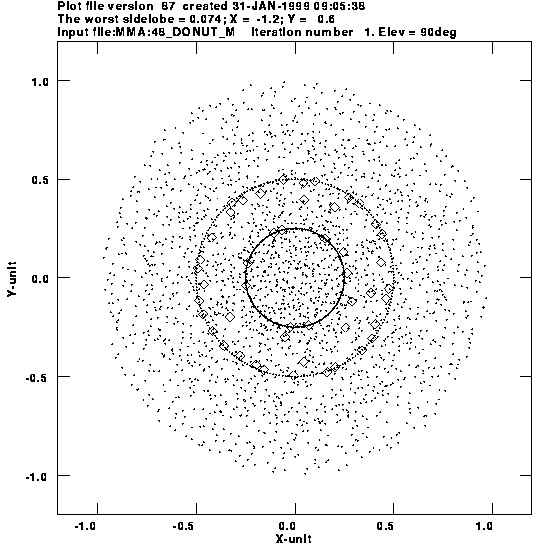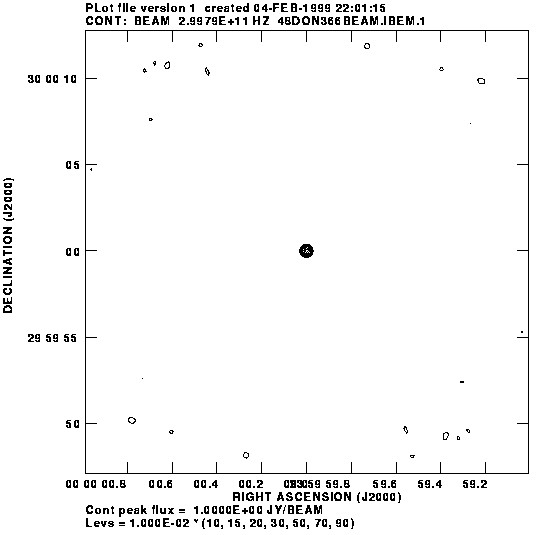
Minutes of meeting Thurs, 25 February 1999 at 11am EST.
Date: 25 February 1999
Time: 11:00 am EST (9:00 am Socorro, 9:00 am Tucson)
Phone: (804)296-7082 (CV SoundStation Premier Conference phone).
Past minutes, etc on MMA Imaging and Calibration Division Page
Agenda
--------
Summary of Conversations between Europeans and Americans on Science and Systems
The number of antennas should target 7000 square meters, or 64 12m diameter antennas. The antennas should be deployed in configurations ranging from a compact array, closely spaced (15-16m) to a large array encompassing 10 to perhaps 20 km diameter. Investiagtion of the optimum pattern for the array will be iterated by US and European groups; the process of identification of specific sites will begin in March when several sites will be visited and staked.
If the acceleration rate specification can be met at reasonable cost, nutating secondaries may not be necessary in the production run of antennas. Holdaway has modeled the noise in total power maps made with an antenna in an unpublished memo. Some tests of this theory will be undertaken by the Cambridge UK group on the JCMT. Currently, specifications on 'On the Fly Mapping' (OTF) along with fast switching, set the acceleration constraints on the antenna, since OTF must be executed sufficiently rapidly to cancel atmospheric variations. The noise achievable in OTF maps should match interferometric noise and not be limited by atmospheric contributions. Neither should receiver noise ('1/f noise') be the limiting factor on image noise. Rough specifications for this are in the project book.
There was some discussion about the science drivers for the 33-45 GHz band. Specifications for this band were developed when the array was planned as 40 x 8m antennas. A committee of proponents of Qband science should re-examine the specifications in light of the planned 64 x 12m antennas--suggested membership Owen, Carlstrom, Uson, Hills.
Care should be taken that overly wide specification in receiver bandwidth does not compromise receiver sensitivity.
The second 183 GHz receiver built by OSO should arrive at Chajnantor in March. The UK (Cambridge) will lead the effort to examine the data from the dual 183 GHz receivers and contrast that data with the 12 GHz interferometer data, and radiosonde data. A goal of these studies, in confunction with similar studies at 22 GHz at OVRO, BIMA, IRAM and the VLA, is to define the algorithmic form by which the data is corrected and to determine a propitious number and spacing of sampling channels, whether a second generation receiver might be cooled, the effects of non-cospatiality of the beams, and receiver design. A further goal is to develop estimates of the ultimate accuracy of phase corrections made using water vapor radiometers.
Polarization of all receivers is to be linear, with a capability to insert e.g. quarter wave plates to provide circular polarization in certain frequency bands. These bands should be selected with regard to continuum sensitivity and availability of molecular transitions suitable for Zeeman experiments.
Receiver bands for evaluation receivers should be as described in the project book. If antennas are moved to the site sooner than projecte in the WBS a 650 GHz receiver should be provided.
Receiver tuning should be possible durint the time scale to move from calibrator to source in a fast switching mode. Simultaneous dual frequency operation is not necessary. Provision should be made such that some operation at 200 microns might be done at a future date.
Over the top telescope operation -- 90 - 130 degree elevation -- offers some advantages for calibration but isn't a scientific imperative. At the highest frequencies, there may be some advantage as one wants to maximize observing time at high elevations.
The promise of the telescope and the site is such that operation at Chajnantor should be a goal to be realized as soon as pracitcal.
A specification for maximum sustained data rate has not yet been set by the science group. System reliability should be considered in design with care to provide maximum sensitivity.
A smaller leaner advisory committee consisting of perhaps six European and six American members should evolve into a replacement for the MAC and SAC. Monthly phone meetings and yearly face to face meetings should occur. Special committees to examine particular issues might be empanelled. There should be a single combined Memo Series and WWW site with mirrors on both sides of the Atlantic.
We have been asked to provide example layouts of the antennas in the LMA, using for example 48 x 12m antennas. These should be from the smallest configuration up to 10 km in extent. We will develop a library of images which can be used for simulation of the effect of observing an astronomical source with a particular strawman array. In view of the European meeting, we will plan for 64 x 12m antennas.
Leonia has run some simulations on sidelobe-optimized arrays. Here, the 48 x 12m arrays lie in double rings with inner and outer radii as given in Tamara's suggestions in last week's meetings. It is very unlikely that we will want to choose arrays that have inner and outer diameters that are on adjacent configurations. This might work well for the compact arrays, but for the larger arrays, this results in uv coverage that is too tapered. The reason for progressively more narrow annuli for the larger configurations is that many observers favor maximum sensitivity at long baselines. Since most of these sources will be compact, we can tolerate somewhat higher sidelobes than in the smaller configurations.
Leonia has optimized arrays meeting the specifications and calculated their instantaneous beams for the four primary arrays expected. The series of figures following shows the results of his work.

| In the first, 130m, array, we have a filled array a filling factor of about 0.4. The antenna stations given as diamonds. Dots show the instantaneous uv coverage of this array. |

| This figure shows the beam of the sidelobe-optimized array shown in the first figure. |

| This figure shows the beam for these sidelobed minimized array configurations. |
Someone (Bryan?) will be at the site next month. It would be useful to have this person examine projected locations of antennas, at least for the A, B, C and D arrays, perhaps flag them with locations determined from a GPS receiver. We'll formulate a plan.
Looks like the European-US meeting in Tucson will occur 21-23 Feb 1999. What MMA Imaging and Calibration tasks might the Europeans aid us in?
1. Investigation of 183 GHz phase correction systems. This would be a continuation of the current program, in which one 183 GHz radiometer is situated at each end of the 12 GHz interferometer baseline at Chajnantor.
2. Investigation of total power imaging modes. The continuing 'DREAM' mode and related modes at the JCMT, as well as characterization of 1/f noise in SIS receivers, could help us to understand problems associated with sensitive total power observing modes.
3. Soil sampling.
4. Configuration studies. There has already been sizable interest in this subject, resulting in several memos in the Memo Series. We need to put prototype 50 x 12m antenna configurations down on a plat of the site, up to 10km in size, for purposes of example. European collaboration in this and in imaging studies seems possible.
Note that the 12m '30th birthday meeting' will be of substantial interest to our group:
6- 9 Jun 'Imaging at Radio through Submillimeter Wavelengths' meeting in Tucson
As you may know, a meeting of U. S. and European scientists is being planned for the Fall of 1999 in Washington, D. C. The goal of the meeting is to review the scientific program planned for the joint array and how that program interacts with the science goals of other astronomical facilities expected to be operational at the time that the MMA/LSA becomes operational.
Please comment upon the prototype WWW page for the Science With A Large Millimeter Array meeting at:
Science topics for this suggestion were drawn from those identified by the 1997 Thaddeus committee (Task Group on Space Astronomy and Astrophysics, Committee on Astronomy and Astrophysics, Board on Physics and Astronomy, Space Studies Board, Commission on Physical Sciences, Mathematics and Applications, National Research Council) report A New Science Strategy for Space Astronomy and Astrophysics", or by McKee:
----------------------------------------------------------------------
--------
UPCOMING REVIEW: On or before 31 May 1999 we review results from the OVRO and BIMA phase correction systems.
DECISION: 183 GHz or 22 GHz phase correction?
DECISION: Is a nutating secondary necessary?
DECISION: What is the effect of 1/f noise in the HEMT amplifiers of SIS receivers upon our ability to combine total power and interferometric images into a faithful representation of the sky?
MEETINGS: MAC meeting 10 Feb 1999 at noon. ------
--------
------
T. Helfer:
A. Wootten: 3-6 Feb (12m observing) 8-9 Feb (MMA talk at SPECS conference) 16 Feb (43m observing) 20-24 Feb Tucson 22-30 May househubby 9 - 13 Jun CSO
J. Mangum:
M. Yun:
B. Butler:
S. Radford: